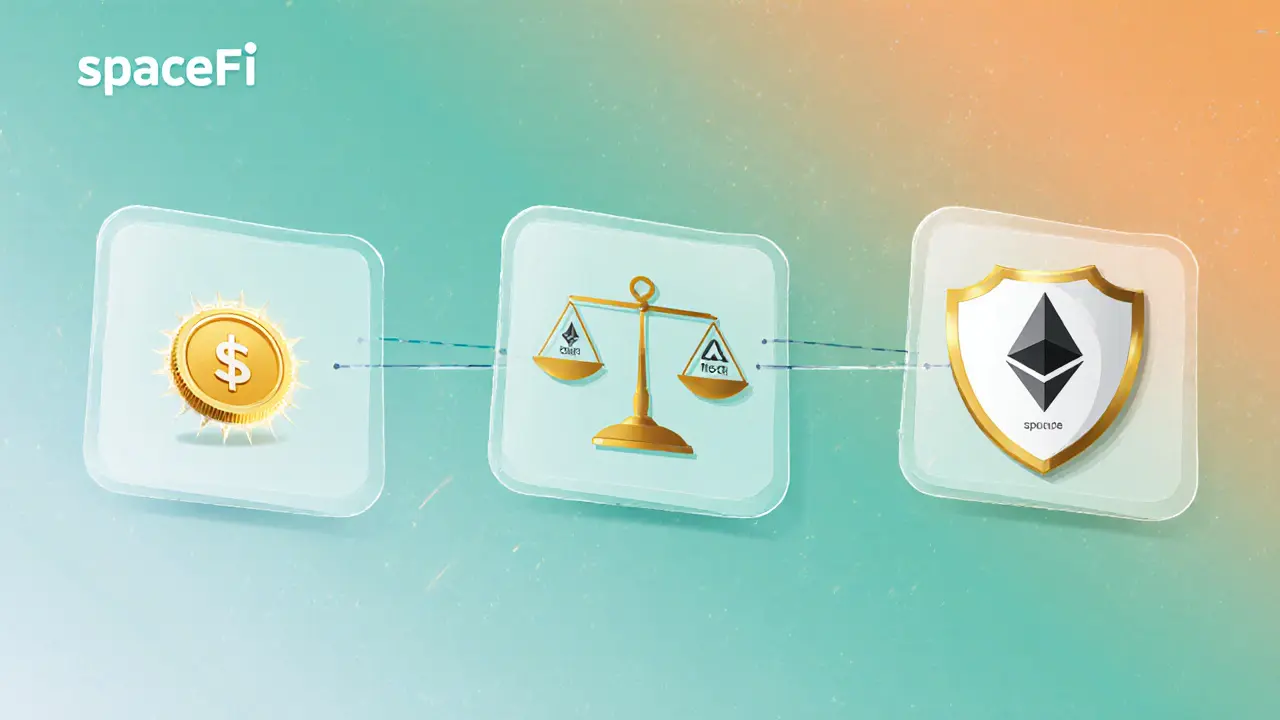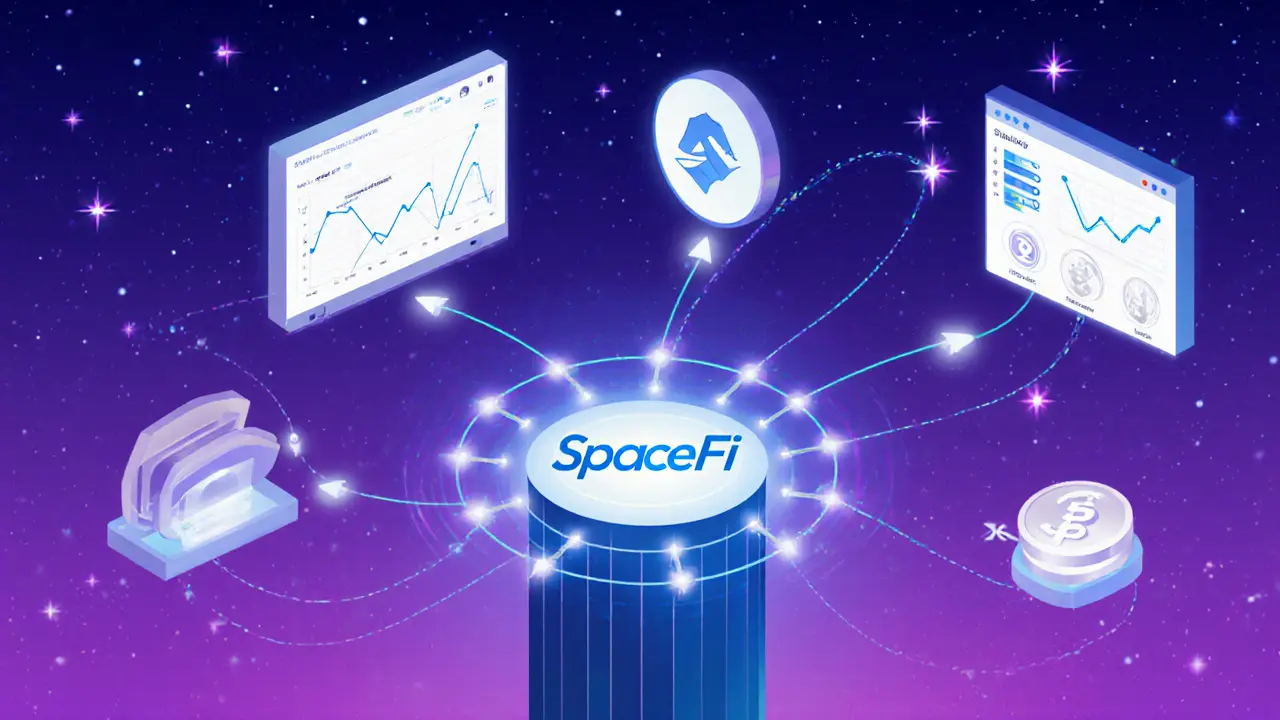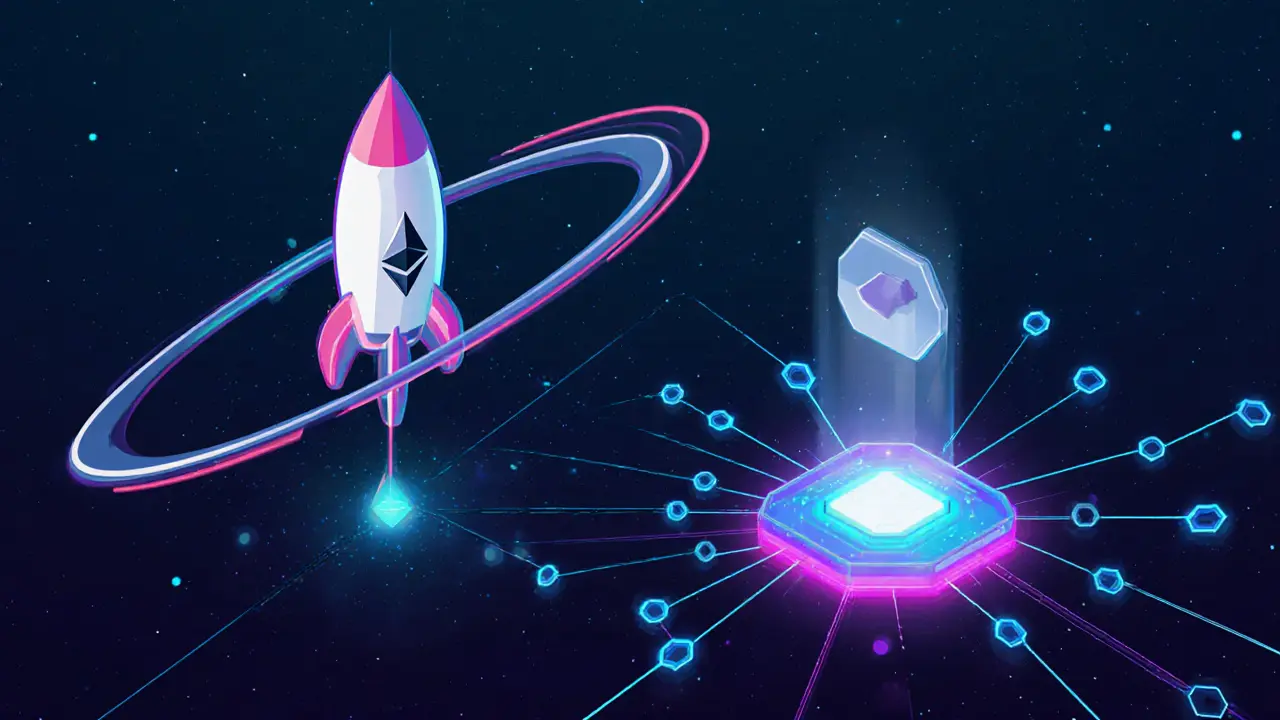SpaceFi zkSync Fee Comparison Calculator
Fee Comparison Overview
This calculator helps you compare SpaceFi's fee structure against other zkSync-compatible exchanges to estimate your trading costs.
| Exchange | Maker Fee | Taker Fee | Withdrawal Cost | Estimated Total Cost |
|---|---|---|---|---|
| SpaceFi | 0.05% | 0.10% | $0.01 | $0.00 |
| MEXC (zkSync layer) | 0.08% | 0.12% | $0.02 | $0.00 |
| SushiSwap (zkSync) | 0% | 0.30% | $0.01 (gas-free) | $0.00 |
Key Takeaways
- SpaceFi runs on zkSync Era, giving near‑zero fees (≈$0.01) and sub‑second confirmations.
- Security inherits Ethereum’s guarantees and adds ZK‑proof verification.
- Supported assets focus on ZK‑rollup projects, with plans to add major DeFi tokens.
- UI is beginner‑friendly but lacks some advanced trading tools found on larger exchanges.
- Roadmap includes cross‑rollup liquidity routing and gas‑abstraction features for 2026.
When you hear the name SpaceFi is a crypto exchange built on the zkSync Layer2 network. It promises the speed and cost benefits of zero‑knowledge rollups while keeping the familiar Ethereum wallet experience.
The underlying protocol, zkSync is a Zero‑Knowledge Rollup (ZK‑rollup) scaling solution for Ethereum, currently ranking among the top Layer2s by total value locked (TVL). With over $830million TVL and transaction fees often under one cent, zkSync creates an attractive playground for new exchanges.
Because SpaceFi is a relatively new player, the review focuses on four core dimensions that matter to anyone considering a switch: fees, security, user experience, and ecosystem fit. Each section pulls data from the zkSync network, public roadmaps, and community feedback.
Why zkSync Matters for an Exchange
Before diving into SpaceFi, it helps to understand the benefits zkSync brings to any trading platform.
- Ultra‑low fees: Batch‑processed transactions cost roughly $0.01, thanks to ZK‑proofs that compress hundreds of transfers into a single on‑chain proof.
- Fast finality: Transactions confirm within 2‑3 seconds, a stark contrast to Ethereum’s 15‑30‑second average.
- Ethereum security: All proofs are verified on Ethereum, so the security model inherits the main chain’s decentralisation.
- EVM compatibility: Developers can deploy Solidity contracts unchanged, meaning DeFi protocols can migrate with minimal friction.
The ecosystem’s robustness is evident from the backing of funds like a16z, Coinbase Ventures, and Consensys, which collectively invested over $458million into zkSync projects.
How SpaceFi Leverages zkSync
SpaceFi’s architecture mirrors zkSync’s rollup design. User deposits are aggregated off‑chain, wrapped into a ZK‑proof, and then posted to Ethereum once per batch. This approach slashes gas costs and allows the exchange to offer “gas‑free” trading for most users.
Key attributes of the platform:
- ZK token is the native utility token for the zkSync network, used for staking, governance, and fee discounts.
- SpaceFi integrates directly with popular Ethereum wallets (MetaMask, Argent, Rainbow) via wallet abstraction, meaning users don’t need a new private key.
- The UI offers a one‑click “Swap” experience, a basic order book, and staking dashboards for ZK.
Fee Structure Breakdown
| Exchange | Maker Fee | Taker Fee | Withdrawal Cost |
|---|---|---|---|
| SpaceFi | 0.05% | 0.10% | $0.01 (zkSync gas) |
| MEXC (zkSync layer) | 0.08% | 0.12% | $0.02 |
| SushiSwap (zkSync) | 0% | 0.30% | $0.01 (gas‑free on‑chain) |
SpaceFi’s maker‑taker split is competitive, especially given the sub‑penny withdrawal fee. For high‑volume traders, the savings can add up quickly.
Security & Custody Model
SpaceFi adopts a non‑custodial design: funds stay in the user’s zkSync wallet until a trade is executed. The exchange only signs transactions; it never holds private keys. This reduces hack surface compared to centralized custodial platforms.
- All trades are recorded on zkSync rollups, verified by Ethereum’s consensus layer.
- SpaceFi undergoes quarterly audits from independent firms (e.g., Quantstamp). The latest report flagged no critical vulnerabilities.
- Bug bounty program rewards up to $25,000 for high‑severity findings, signalling a proactive security posture.

User Experience & Interface
The platform targets both beginners and intermediate traders. The dashboard presents three main tabs: “Swap”, “Order Book”, and “Staking”.
- Swap: One‑click token swaps with real‑time quotes; ideal for quick moves between ZK‑ecosystem assets.
- Order Book: Limited depth (up to 10 price levels) but sufficient for most retail volume.
- Staking: Users can lock ZK and earn up to 6% APY, paid in ZK.
Mobile responsiveness is solid, though the native iOS/Android apps are still in beta as of October2025.
Supported Assets & Liquidity
SpaceFi currently lists 35 tokens, focusing on projects built on zkSync or with zk‑optimised bridges. Highlights include:
- ZK - native token, heavy liquidity due to staking incentives.
- zkSync‑wrapped ETH (WETH‑z)
- Stablecoins USDC‑z and USDT‑z (both zkSync‑bridged).
- DeFi protocols like Aave‑z and Uniswap‑z.
Liquidity on the order book is sourced from a combination of on‑chain pools and market‑making bots. Average slippage for a $10,000 trade sits around 0.12%, which is respectable for a niche Layer2 exchange.
Roadmap & Future Features
SpaceFi’s public roadmap outlines three milestones for 2025‑2026:
- Cross‑rollup liquidity routing: Integration with Starknet and Polygon zkEVM to aggregate order books across L2s.
- Gas‑abstraction payments: Allow users to pay fees with stablecoins or ZK, removing the need to hold ETH for gas.
- Advanced analytics dashboard: Real‑time P&L charts, on‑chain order flow visualisation, and API access for bots.
These upgrades aim to bridge the gap between niche zkSync DEXs and larger centralized exchanges.
Pros & Cons Summary
- + Near‑zero fees thanks to zkSync rollups.
- + Non‑custodial architecture enhances security.
- + Simple UI lowers entry barrier for new users.
- - Limited asset list compared to major CEXs.
- - Order‑book depth may not satisfy high‑frequency traders.
- - Mobile apps still in beta, occasional UI glitches.
Who Should Use SpaceFi?
If you trade primarily ZK‑rollup tokens, want to keep transaction costs at pennies, and value a non‑custodial setup, SpaceFi is a solid choice. Power traders seeking deep order‑book depth or a wide range of fiat on‑ramps might still prefer larger centralized platforms for now.
Frequently Asked Questions
Is SpaceFi fully non‑custodial?
Yes. Your private keys stay in your zkSync‑compatible wallet. SpaceFi only signs trade orders; it never holds your assets.
How do I fund my SpaceFi account?
Connect any Ethereum wallet that supports zkSync (MetaMask, Argent, etc.), bridge the desired token to zkSync, and the balance appears instantly on SpaceFi.
What are the withdrawal fees?
Withdrawals to the zkSync layer cost roughly $0.01 (the on‑chain gas fee). Moving funds back to Ethereum mainnet costs an additional $0.02‑$0.03, depending on network load.
Can I trade on margin?
As of October2025, SpaceFi does not offer leveraged or margin trading. The focus is on spot swaps and staking.
Is there a native token for SpaceFi?
SpaceFi does not have its own token yet. It uses the zkSync ZK token for fee discounts and staking rewards.

Final Verdict
SpaceFi showcases what a purpose‑built zkSync exchange can achieve: ultra‑low fees, fast confirmations, and a security model anchored to Ethereum. While the platform’s asset range and advanced features lag behind big centralized players, the trade‑off feels intentional-focus on the zk ecosystem, keep costs down, and stay non‑custodial.
For users already comfortable with zkSync or looking to experiment with ZK‑rollup DeFi, SpaceFi offers an engaging, cost‑effective gateway. Keep an eye on the upcoming cross‑rollup liquidity router; once that lands, the exchange could become a central hub for the whole zk‑layer universe.


17 Responses
I totally get the excitement around SpaceFi’s near‑zero fees – it feels like a breath of fresh air for traders who hate seeing pennies disappear on gas. The non‑custodial design also means you keep full control of your keys, which is a massive confidence boost. While the asset list is still small, the speed and cheapness can really level the playing field for newcomers. I’d say give it a try on a modest amount first, just to feel the sub‑second confirmations yourself. If it lives up to the promises, you’ll wonder how you ever traded anywhere else.
SpaceFi looks slick, but the order‑book depth feels a bit thin for big moves.
Hey folks, I’m thrilled to see a zkSync‑native exchange finally taking shape! The ultra‑low fees are perfect for those who want to hop in and out without worrying about cost. The UI is clean enough that even my grandma could place a swap in seconds. Keep an eye on their roadmap – cross‑rollup routing could turn SpaceFi into a real hub for the whole ZK ecosystem.
Alright, let’s talk about why SpaceFi is a game‑changer! First off, those sub‑cent withdrawals? Pure magic for day traders grinding on thin margins. Second, the whole non‑custodial vibe screams security – no more “centralized vault” nightmares. Third, the UI, while simple, packs a punch with one‑click swaps and a neat staking tab. Sure, the token roster isn’t massive yet, but that’s a conscious focus on quality over quantity. Trust me, once the cross‑rollup router lands, you’ll be shouting from the rooftops about this platform.
Enya makes a solid point about the trade‑off between breadth and depth. From a philosophical lens, a platform that prioritizes security and fee efficiency embodies the core ethos of decentralisation. The minimalist asset list can be seen as a curated approach, reducing surface‑area for attacks. As the ecosystem matures, we’ll likely witness organic growth in listings driven by community demand. In the meantime, users can benefit from the rock‑solid foundation that SpaceFi builds on zkSync.
The security model of SpaceFi is nothing short of impressive, given that every transaction is ultimately validated on Ethereum’s consensus layer. Their quarterly audits, especially the recent Quantstamp report, found no critical flaws, which should reassure risk‑averse traders. Moreover, the bug bounty program, with rewards up to $25,000, signals a proactive stance against vulnerabilities. Non‑custodial custody means your private keys never leave your wallet, dramatically reducing the attack surface. All these factors combine to make SpaceFi a compelling option for those who value safety as much as speed.
Yep, the audit trail and bug‑bounty pipeline are solid compliance checks.
While everyone’s singing praises about zero‑fee trading, we shouldn’t ignore the hidden costs of limited liquidity. A thin order book can cause slippage that eats away any fee savings. Sometimes, paying a modest fee for deeper markets is the smarter move.
SpaceFi’s UI is sooo sleek!!! But the asset list?? It’s *tiny*…
Don’t be fooled by the pretty interface – the underlying rollup could be a front for data leaks. Remember, every “sub‑cent” fee still requires a bridge transaction that could be compromised. Stay vigilant and diversify your L2 exposure.
Team, if you’re on the fence about trying SpaceFi, think of it as a testing ground for the zkSync ecosystem. Start with a small amount and experience the sub‑second confirmations yourself. The staking rewards on ZK can also give you a nice passive boost while you explore. Share your findings – the community thrives on collaborative learning!
Sure, because everyone loves risking their first dollar on a beta exchange. 🙄
Hey all, just wanted to add a quick note about the withdrawal fees. The $0.01 on‑chain cost is basically nothing, especially when you compare it to traditional exchanges. However, moving back to mainnet can still be a few cents, so keep that in mind for big transfers. Also, the staking dashboard could use a bit more polish – some buttons feel a little wonky. Overall, SpaceFi is shaping up nicely, keep an eye on those upcoming updates.
From a systems‑engineering perspective, the fee architecture of SpaceFi leverages the intrinsic scaling properties of zkRollups, thereby achieving a cost model that approaches the theoretical minimum transaction overhead onLayer‑2 solutions; this is particularly salient when juxtaposed against the fee structures of traditional centralized exchanges, which often embed hidden spreads within their quoted rates. Moreover, the utilization of zkSync’s batch‑proof generation algorithm facilitates a deterministic gas‑cost amortization across hundreds of trades, effectively diluting the marginal cost per transaction to sub‑cent levels, a phenomenon well‑documented in recent academic analyses of zero‑knowledge proof efficiency. The non‑custodial custody paradigm employed by SpaceFi circumvents the systemic risk associated with centralized asset repositories, aligning with the broader decentralization ethos that underpins the Ethereum ecosystem, and further mitigates exposure to single‑point‑of‑failure attack vectors. In addition, the platform’s integration of the ZK native token as both a fee‑discount mechanism and a staking incentive creates a self‑reinforcing economic loop, wherein token holders are naturally motivated to provide liquidity, thereby enhancing market depth over time. While the current token enumeration is modest, the strategic focus on zkSync‑compatible assets ensures that liquidity is concentrated in high‑velocity, low‑latency markets, reducing the latency‑induced arbitrage opportunities that often plague nascent DEXs. The roadmap’s emphasis on cross‑rollup liquidity routing is poised to introduce inter‑protocol composability, effectively bridging the siloed DeFi landscapes of Starknet, Polygon zkEVM, and other zero‑knowledge ecosystems, which in turn could catalyze a degree of market integration hitherto unseen in the Layer‑2 domain. Furthermore, the upcoming gas‑abstraction feature stands to abstract away ETH as a requisite for transaction fee settlement, leveraging stablecoin or ZK token balances directly, which would streamline the user experience and lower entry barriers for non‑technical participants. Security audits conducted by Quantstamp, complemented by a generous bug bounty program capped at $25k, provide an empirical assurance of code robustness, though continuous vigilance remains imperative given the evolving threat landscape inherent to cryptographic protocols. The UI/UX, while currently functional, could benefit from iterative user‑testing cycles to refine responsiveness and accessibility, particularly as the platform scales its user base beyond early adopters. In sum, SpaceFi exemplifies a meticulously architected convergence of low‑cost transaction processing, rigorous security posturing, and forward‑looking product development, positioning it as a compelling contender in the burgeoning zkRollup exchange arena. As the DeFi community gravitates toward more sustainable scaling solutions, platforms that embody these principles are likely to capture a disproportionate share of the market’s growth trajectory. Therefore, stakeholders and prospective traders alike should monitor SpaceFi’s evolution with calibrated optimism, recognizing both its current strengths and the latent potential unlocked by its strategic roadmap. Future integrations with on‑chain analytics tools could further empower users to make data‑driven decisions. Community governance mechanisms, once implemented, will give token holders a direct voice in protocol upgrades. Overall, the synergy of technical excellence and community focus makes SpaceFi a noteworthy player to watch.
I’ve been watching the zkSync space evolve for a while, and SpaceFi feels like a natural next step in that journey. The ultra‑low fees directly address one of the biggest pain points for retail traders, especially those who make frequent, small trades. Its non‑custodial design resonates with the security‑first mindset that many of us hold dear. While the current asset list is modest, the focus on quality over quantity can actually foster a tighter, more reliable market. The roadmap’s cross‑rollup ambitions suggest that this platform could become a central hub, linking multiple Layer 2 ecosystems together. If you give it a spin, you’ll likely appreciate how the sub‑second finality changes the whole trading experience.
Sure, but don’t get your hopes up – “cross‑rollup” hype often stalls at beta stage.
Everyone, let’s keep the conversation constructive and focus on what the platform does well while acknowledging its limits. The fee structure is a clear win for cost‑sensitive users, and the security model aligns with decentralization principles. At the same time, we should monitor liquidity growth and UI refinements as the project matures. Collaborative feedback will help SpaceFi evolve into a more robust solution for the broader crypto community.